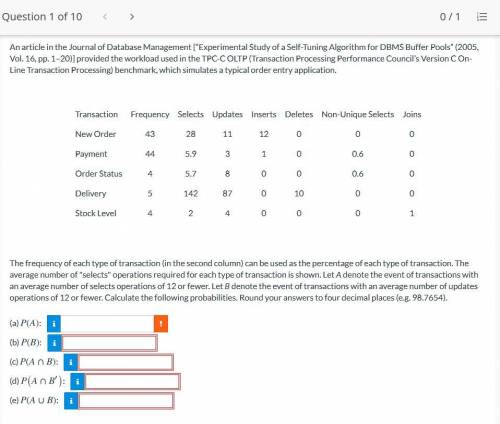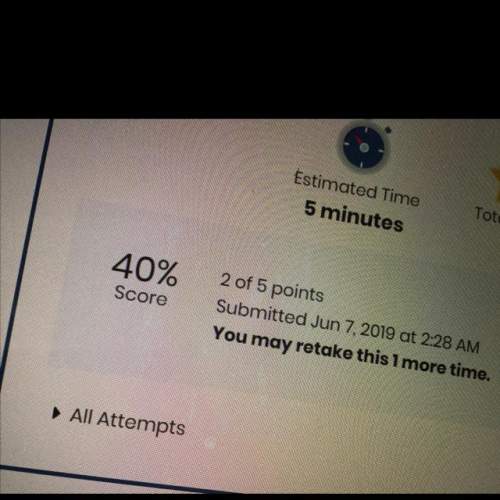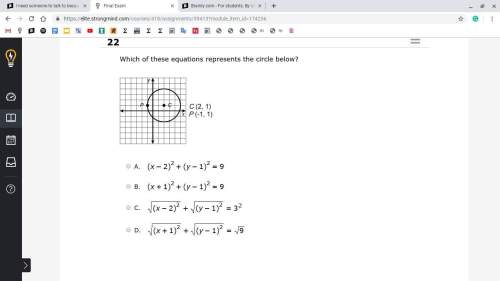
Mathematics, 31.08.2021 07:50 iBrain
An article in the Journal of Database Management [“Experimental Study of a Self-Tuning Algorithm for DBMS Buffer Pools” (2005, Vol. 16, pp. 1–20)] provided the workload used in the TPC-C OLTP (Transaction Processing Performance Council’s Version C On-Line Transaction Processing) benchmark, which simulates a typical order entry application.
Transaction Frequency Selects Updates Inserts Deletes Non-Unique Selects Joins
New Order 43 28 11 12 0 0 0
Payment 44 5.9 3 1 0 0.6 0
Order Status 4 5.7 8 0 0 0.6 0
Delivery 5 142 87 0 10 0 0
Stock Level 4 2 4 0 0 0 1
The frequency of each type of transaction (in the second column) can be used as the percentage of each type of transaction. The average number of "selects" operations required for each type of transaction is shown. Let A denote the event of transactions with an average number of selects operations of 12 or fewer. Let B denote the event of transactions with an average number of updates operations of 12 or fewer. Calculate the following probabilities. Round your answers to four decimal places (e. g. 98.7654).


Answers: 1
Another question on Mathematics

Mathematics, 21.06.2019 14:00
Use the inverse of the function y=x^2-18x to find the unknown value [tex]y = \sqrt{bx + c \: + d} [/tex]
Answers: 3

Mathematics, 21.06.2019 17:00
In tossing one coin 10 times, what are your chances for tossing a head? a tail? 2. in tossing one coin 100 times, what are your chances for tossing a head? a tail? 3. in tossing one coin 200 times, what are your chances for tossing a head? a tail? deviation = ((absolute value of the difference between expected heads and observed heads) + (absolute value of the difference between expected tails and observed tails)) divided by total number of tosses. this value should always be positive. 4. what is the deviation for 10 tosses? 5. what is the deviation for the 100 tosses? 6. what is the deviation for 200 tosses? 7. how does increasing the total number of coin tosses from 10 to 100 affect the deviation? 8. how does increasing the total number of tosses from 100 to 200 affect the deviation? 9. what two important probability principles were established in this exercise? 10. the percent of occurrence is the obtained results divided by the total tosses and multiplied by 100%. toss the coins 100 times and record your results. calculate the percent occurrence for each combination. percent head-head occurrence: percent tail-tail occurrence: percent head-tail occurrence:
Answers: 3

Mathematics, 21.06.2019 23:30
Answer each of the questions for the following diagram: 1. what type of angles are these? 2. solve for x. what does x equal? 3. what is the measure of the angles?
Answers: 1

Mathematics, 22.06.2019 01:10
Awavelength of 610 nm was found to be the most intense wavelength emitted by copper. answer the following questions about this wavelength of light. a) what is this wavelength in cm? b) what is the frequency that corresponds to this wavelength? c) what is the energy of light of this wavelength? d) what is the wavenumber corresponding to this wavelength?
Answers: 2
You know the right answer?
An article in the Journal of Database Management [“Experimental Study of a Self-Tuning Algorithm for...
Questions

Mathematics, 03.02.2020 11:50

History, 03.02.2020 11:50


Biology, 03.02.2020 11:50


Biology, 03.02.2020 11:50


Mathematics, 03.02.2020 11:50

Social Studies, 03.02.2020 11:50

Mathematics, 03.02.2020 11:50



Mathematics, 03.02.2020 11:50

Social Studies, 03.02.2020 11:50

History, 03.02.2020 11:50



Health, 03.02.2020 11:50

Social Studies, 03.02.2020 11:50

Mathematics, 03.02.2020 11:50





